|
|
ORIGEN DEL PATRON PLEYADES-ORION-SIRIO, EN EL MARCO A LA INDEPENDENCIA DE LOS ESTADOS UNIDOS, A LA MASONERIA, LA EGIPTOLOGIA, EL ISLAM, EL CATOLICISMO ESOTERICO, LA CIENCIA, EL SIONISMO, EL CAPITALISMO, CULTURA BABILONICA, SUMERIA, MAYA, ETC, ETC TIENE FUERTE RELACION CON LA CIUDAD DE JERUSALEN (LOBO, PERRO, CHACAL)-ULTRA SECRETO ESOTERICO DEL PORQUE DE LAS "RELACIONES CARNALES" ENTRE LOS ESTADOS UNIDOS CON EL SIONISMO
DAVINCI/DAVID
A/ESPADA/BLADE/SIMBOLO FALICO
V/CALIZ/CHALICE/RECIPIENTE/SIMBOLO FEMENINO
JERUSALEN/USA
JERUSALEN/JUAN/JVAN/33
HECHOS 12:12 (33)
JER/33
| milky way in Simple Gematria Equals: 119 |
( |
m 13 |
i9 |
l 12 |
k 11 |
y 25 |
0 |
w 23 |
a1 |
y 25 |
) |
| queen mary in Simple Gematria Equals: 119 |
( |
q 17 |
u 21 |
e5 |
e5 |
n 14 |
0 |
m 13 |
a1 |
r 18 |
y 25 |
|
| hebrew calendar in Simple Gematria Equals: 119 |
( |
h8 |
e5 |
b2 |
r 18 |
e5 |
w 23 |
0 |
c3 |
a1 |
l 12 |
e5 |
n 14 |
d4 |
a1 |
r 18 |
| mary magdalene in Simple Gematria Equals: 119 |
( |
m 13 |
a1 |
r 18 |
y 25 |
0 |
m 13 |
a1 |
g7 |
d4 |
a1 |
l 12 |
e5 |
n 14 |
e5 |
|
JERUSALEN ESTABA EN EL ANTIGUO TERRITORIO DE BENJAMIN/PERRO/LOBO/CHACAL
1. Génesis 49:27: Benjamín es LOBO arrebatador; A la mañana comerá la presa, Y a la tarde repartirá los despojos.
|
Apocalipsis 17:9. Para comprender esto, es necesario tener inteligencia y sutileza. Las siete cabezas son las siete colinas, sobre las cuales está sentada la mujer.
Veamos cuantas colinas tiene Jerusalén de los tiempos de Jesús y de San Juan Apóstol quien escribe estas palabras.

En la cultura oriental a la que pertenece San Juan, Jerusalén era conocida como “la ciudad de las siete colinas”. Esto lo confirma el texto histórico judío Pirke de-Rabbi Eliezer en la sección 10. Las siete colinas son Ophel, Sión, Moria, Besetha, Acra, Gareb y Goath. Recordemos que “siete” es el número de Dios en el lenguaje judío. Por eso allí la Ciudad para el Señor.
Si nos fijamos bien, podemos ver en esta ilustración algunas de las colinas. Se contempla Ophel, Moria y algo de Sión y Acra.


|
|
JOSUE 18
20. Y el Jordán era el límite al lado del oriente. Esta es la heredad de los hijos de Benjamín por sus límites alrededor, conforme a sus familias.
21. Las ciudades de la tribu de los hijos de Benjamín, por sus familias, fueron Jericó, Bet-hogla, el valle de Casis,
22. Bet-arabá, Zemaraim, Bet-el,
23. Avim, Pará, Ofra,
24. Quefar-haamoni, Ofni y Geba; doce ciudades con sus aldeas;
25. Gabaón, Ramá, Beerot,
26. Mizpa, Cafira, Mozah,
27. Requem, Irpeel, Tarala,
28. Zela, Elef, Jebús (que es Jerusalén), Gabaa y Quiriat; catorce ciudades con sus aldeas. Esta es la heredad de los hijos de Benjamín conforme a sus familias.
NUMERO 33 (RELACION CON EL PERIODO SIDEREO DE MERCURIO) / ESTRELLA DE DAVID / INTERRELACION CON ORION EN FUNCION AL AFELIO Y PERIHELIO DE MERCURIO
|
|
A gauche, l'emblème maçonnique.
A droite, l'"étoile de David".
Deux barres ou lignes horizontales appliquées sur le compas et l'équerre maçonniques suffisent à faire de l'emblème une étoile de David.
|
|
|
|
USA/UVA/VID/LINAJE
VA=ESTRELLA DE 6 PUNTAS=33=LL-AV-E DE D-AV-ID/D-AV-INCI
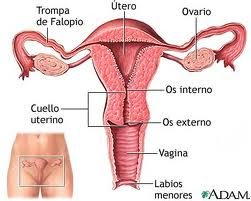
En aquel tiempo, respondiendo Jesús, dijo:
Te alabo, Padre, Señor del cielo y de la tierra,
que hayas escondido estas cosas (la Gnosis, la Sabiduría Oculta)
de los sabios (de los eruditos) y de los entendidos, (de los intelectuales)
y las hayas revelado á los niños. (A los Iniciados). Así, Padre, pues que así agradó en tus ojos."
(Mateo 11: 25-26). (El cielo y la tierra, es la alquimia, osea la ESCALERA DE JACOB. La cuadratura del circulo es el patron matematico de la alquimia y esta basado, insisto, en el numero de oro. Justamente Salomon es un tipo del GRIAL.)
"¡Oh profundidad de las riquezas de la sabiduría (sophia)
y de la ciencia (gnwsiV, gnosis) de Dios!
¡Cuán incomprensibles son sus juicios, e inescrutables sus caminos!"
(Romanos, 11: 33). (Camino es una referencia a MERCURIO y Juicio es una referencia a ORION=ESPADA. EL NUMERO 33 NO ESTA POR CASUALIDAD. ES UNA REFERENCIA A LA ESTRELLA DE 6 PUNTAS. OSEA QUE EN LA MISMA PALABRA ESTA CODIFICADA LA RELACION ORION-MERCURIO-VIA LACTEA. PENSAR QUE HAY IGNORANTES QUE DICEN QUE LOS ESCRITORES DE LA BIBLIA NO CONOCIAN EL PI. ESA ES LA SOBERBIA DEL SER HUMANO QUE SE CREE TENER MAS DERECHOS QUE EL CREADOR. ASI ESTA EL MUNDO. SOLO EN JESUCRISTO ESTA LA VERDADERA LIBERACION DE LA EGOLATRIA, IDOLATRIA Y DEL PECADO.)
BENJAMIN/PERRO/
LOBO/CHACAL
|
|
|
|
|
|
DAVINCI/DAVID
A/ESPADA/BLADE/SIMBOLO FALICO
V/CALIZ/CHALICE/RECIPIENTE/SIMBOLO FEMENINO
JERUSALEN/USA
JERUSALEN/JUAN/JVAN/33
HECHOS 12:12 (33)
JER/33
| milky way in Simple Gematria Equals: 119 |
( |
m 13 |
i9 |
l 12 |
k 11 |
y 25 |
0 |
w 23 |
a1 |
y 25 |
) |
| queen mary in Simple Gematria Equals: 119 |
( |
q 17 |
u 21 |
e5 |
e5 |
n 14 |
0 |
m 13 |
a1 |
r 18 |
y 25 |
|
| hebrew calendar in Simple Gematria Equals: 119 |
( |
h8 |
e5 |
b2 |
r 18 |
e5 |
w 23 |
0 |
c3 |
a1 |
l 12 |
e5 |
n 14 |
d4 |
a1 |
r 18 |
| mary magdalene in Simple Gematria Equals: 119 |
( |
m 13 |
a1 |
r 18 |
y 25 |
0 |
m 13 |
a1 |
g7 |
d4 |
a1 |
l 12 |
e5 |
n 14 |
e5 |
|
JERUSALEN ESTABA EN EL ANTIGUO TERRITORIO DE BENJAMIN/PERRO/LOBO/CHACAL
1. Génesis 49:27: Benjamín es LOBO arrebatador; A la mañana comerá la presa, Y a la tarde repartirá los despojos.
|
Apocalipsis 17:9. Para comprender esto, es necesario tener inteligencia y sutileza. Las siete cabezas son las siete colinas, sobre las cuales está sentada la mujer.
Veamos cuantas colinas tiene Jerusalén de los tiempos de Jesús y de San Juan Apóstol quien escribe estas palabras.

En la cultura oriental a la que pertenece San Juan, Jerusalén era conocida como “la ciudad de las siete colinas”. Esto lo confirma el texto histórico judío Pirke de-Rabbi Eliezer en la sección 10. Las siete colinas son Ophel, Sión, Moria, Besetha, Acra, Gareb y Goath. Recordemos que “siete” es el número de Dios en el lenguaje judío. Por eso allí la Ciudad para el Señor.
Si nos fijamos bien, podemos ver en esta ilustración algunas de las colinas. Se contempla Ophel, Moria y algo de Sión y Acra.


|
|
JOSUE 18
20. Y el Jordán era el límite al lado del oriente. Esta es la heredad de los hijos de Benjamín por sus límites alrededor, conforme a sus familias.
21. Las ciudades de la tribu de los hijos de Benjamín, por sus familias, fueron Jericó, Bet-hogla, el valle de Casis,
22. Bet-arabá, Zemaraim, Bet-el,
23. Avim, Pará, Ofra,
24. Quefar-haamoni, Ofni y Geba; doce ciudades con sus aldeas;
25. Gabaón, Ramá, Beerot,
26. Mizpa, Cafira, Mozah,
27. Requem, Irpeel, Tarala,
28. Zela, Elef, Jebús (que es Jerusalén), Gabaa y Quiriat; catorce ciudades con sus aldeas. Esta es la heredad de los hijos de Benjamín conforme a sus familias.
|
|
|
|
|
|
UNA REINA ESCONDIDA O DE "CONTRABANDO" SALVO AL PUEBLO JUDIO DE LA PERSECUCION DE AMAN A LOS JUDIOS- NADIE SABIA QUE ERA JUDIA- ES UN TIPO DE LA NUEVA REINA ESCONDIDA QUE SALVARA A LOS NUEVOS ISRAELITAS
Ester 2
1. Pasadas estas cosas, sosegada ya la ira del rey Asuero, se acordó de Vasti y de lo que ella había hecho, y de la sentencia contra ella.
2. Y dijeron los criados del rey, sus cortesanos: Busquen para el rey jóvenes vírgenes de buen parecer;
3. y ponga el rey personas en todas las provincias de su reino, que lleven a todas las jóvenes vírgenes de buen parecer a Susa, residencia real, a la casa de las mujeres, al cuidado de Hegai eunuco del rey, guarda de las mujeres, y que les den sus atavíos;
4. y la doncella que agrade a los ojos del rey, reine en lugar de Vasti. Esto agradó a los ojos del rey, y lo hizo así.
5. Había en Susa residencia real un varón judío cuyo nombre era Mardoqueo hijo de Jair, hijo de Simei, hijo de Cis, del linaje de Benjamín;
6. el cual había sido transportado de Jerusalén con los cautivos que fueron llevados con Jeconías rey de Judá, a quien hizo transportar Nabucodonosor rey de Babilonia.
7. Y había criado a Hadasa, es decir, Ester, hija de su tío, porque era húerfana; y la joven era de hermosa figura y de buen parecer. Cuando su padre y su madre murieron, Mardoqueo la adoptó como hija suya.
8. Sucedió, pues, que cuando se divulgó el mandamiento y decreto del rey, y habían reunido a muchas doncellas en Susa residencia real, a cargo de Hegai, Ester también fue llevada a la casa del rey, al cuidado de Hegai guarda de las mujeres.
9. Y la doncella agradó a sus ojos, y halló gracia delante de él, por lo que hizo darle prontamente atavíos y alimentos, y le dio también siete doncellas especiales de la casa del rey; y la llevó con sus doncellas a lo mejor de la casa de las mujeres.
10. Ester no declaró cuál era su pueblo ni su parentela, porque Mardoqueo le había mandado que no lo declarase.
11. Y cada día Mardoqueo se paseaba delante del patio de la casa de las mujeres, para saber cómo le iba a Ester, y cómo la trataban.
12. Y cuando llegaba el tiempo de cada una de las doncellas para venir al rey Asuero, después de haber estado doce meses conforme a la ley acerca de las mujeres, pues así se cumplía el tiempo de sus atavíos, esto es, seis meses con óleo de mirra y seis meses con perfumes aromáticos y afeites de mujeres,
13. entonces la doncella venía así al rey. Todo lo que ella pedía se le daba, para venir ataviada con ello desde la casa de las mujeres hasta la casa del rey.
14. Ella venía por la tarde, y a la mañana siguiente volvía a la casa segunda de las mujeres, al cargo de Saasgaz eunuco del rey, guarda de las concubinas; no venía más al rey, salvo si el rey la quería y era llamada por nombre.
15. Cuando le llegó a Ester, hija de Abihail tío de Mardoqueo, quien la había tomado por hija, el tiempo de venir al rey, ninguna cosa procuró sino lo que dijo Hegai eunuco del rey, guarda de las mujeres; y ganaba Ester el favor de todos los que la veían.
16. Fue, pues, Ester llevada al rey Asuero a su casa real en el mes décimo, que es el mes de Tebet, en el año séptimo de su reinado.
17. Y el rey amó a Ester más que a todas las otras mujeres, y halló ella gracia y benevolencia delante de él más que todas las demás vírgenes; y puso la corona real en su cabeza, y la hizo reina en lugar de Vasti.
18. Hizo luego el rey un gran banquete a todos sus príncipes y siervos, el banquete de Ester; y disminuyó tributos a las provincias, e hizo y dio mercedes conforme a la generosidad real.
19. Cuando las vírgenes eran reunidas la segunda vez, Mardoqueo estaba sentado a la puerta del rey.
20. Y Ester, según le había mandado Mardoqueo, no había declarado su nación ni su pueblo; porque Ester hacía lo que decía Mardoqueo, como cuando él la educaba.
21. En aquellos días, estando Mardoqueo sentado a la puerta del rey, se enojaron Bigtán y Teres, dos eunucos del rey, de la guardia de la puerta, y procuraban poner mano en el rey Asuero.
22. Cuando Mardoqueo entendió esto, lo denunció a la reina Ester, y Ester lo dijo al rey en nombre de Mardoqueo.
23. Se hizo investigación del asunto, y fue hallado cierto; por tanto, los dos eunucos fueron colgados en una horca. Y fue escrito el caso en el libro de las crónicas del rey.
Ester 3
1. Después de estas cosas el rey Asuero engrandeció a Amán hijo de Hamedata agagueo, y lo honró, y puso su silla sobre todos los príncipes que estaban con él.
2. Y todos los siervos del rey que estaban a la puerta del rey se arrodillaban y se inclinaban ante Amán, porque así lo había mandado el rey; pero Mardoqueo ni se arrodillaba ni se humillaba.
3. Y los siervos del rey que estaban a la puerta preguntaron a Mardoqueo: ¿Por qué traspasas el mandamiento del rey?
4. Aconteció que hablándole cada día de esta manera, y no escuchándolos él, lo denunciaron a Amán, para ver si Mardoqueo se mantendría firme en su dicho; porque ya él les había declarado que era judío.
5. Y vio Amán que Mardoqueo ni se arrodillaba ni se humillaba delante de él; y se llenó de ira.
6. Pero tuvo en poco poner mano en Mardoqueo solamente, pues ya le habían declarado cuál era el pueblo de Mardoqueo; y procuró Amán destruir a todos los judíos que había en el reino de Asuero, al pueblo de Mardoqueo.
7. En el mes primero, que es el mes de Nisán, en el año duodécimo del rey Asuero, fue echada Pur, esto es, la suerte, delante de Amán, suerte para cada día y cada mes del año; y salió el mes duodécimo, que es el mes de Adar.
8. Y dijo Amán al rey Asuero: Hay un pueblo esparcido y distribuido entre los pueblos en todas las provincias de tu reino, y sus leyes son diferentes de las de todo pueblo, y no guardan las leyes del rey, y al rey nada le beneficia el dejarlos vivir.
9. Si place al rey, decrete que sean destruidos; y yo pesaré diez mil talentos de plata a los que manejan la hacienda, para que sean traídos a los tesoros del rey.
10. Entonces el rey quitó el anillo de su mano, y lo dio a Amán hijo de Hamedata agagueo, enemigo de los judíos,
11. y le dijo: La plata que ofreces sea para ti, y asimismo el pueblo, para que hagas de él lo que bien te pareciere.
12. Entonces fueron llamados los escribanos del rey en el mes primero, al día trece del mismo, y fue escrito conforme a todo lo que mandó Amán, a los sátrapas del rey, a los capitanes que estaban sobre cada provincia y a los príncipes de cada pueblo, a cada provincia según su escritura, y a cada pueblo según su lengua; en nombre del rey Asuero fue escrito, y sellado con el anillo del rey.
13. Y fueron enviadas cartas por medio de correos a todas las provincias del rey, con la orden de destruir, matar y exterminar a todos los judíos, jóvenes y ancianos, niños y mujeres, en un mismo día, en el día trece del mes duodécimo, que es el mes de Adar, y de apoderarse de sus bienes.
14. La copia del escrito que se dio por mandamiento en cada provincia fue publicada a todos los pueblos, a fin de que estuviesen listos para aquel día.
15. Y salieron los correos prontamente por mandato del rey, y el edicto fue dado en Susa capital del reino. Y el rey y Amán se sentaron a beber; pero la ciudad de Susa estaba conmovida.
Ester 4
1. Luego que supo Mardoqueo todo lo que se había hecho, rasgó sus vestidos, se vistió de cilicio y de ceniza, y se fue por la ciudad clamando con grande y amargo clamor.
2. Y vino hasta delante de la puerta del rey; pues no era lícito pasar adentro de la puerta del rey con vestido de cilicio.
3. Y en cada provincia y lugar donde el mandamiento del rey y su decreto llegaba, tenían los judíos gran luto, ayuno, lloro y lamentación; cilicio y ceniza era la cama de muchos.
4. Y vinieron las doncellas de Ester, y sus eunucos, y se lo dijeron. Entonces la reina tuvo gran dolor, y envió vestidos para hacer vestir a Mardoqueo, y hacerle quitar el cilicio; mas él no los aceptó.
5. Entonces Ester llamó a Hatac, uno de los eunucos del rey, que él había puesto al servicio de ella, y lo mandó a Mardoqueo, con orden de saber qué sucedía, y por qué estaba así.
6. Salió, pues, Hatac a ver a Mardoqueo, a la plaza de la ciudad, que estaba delante de la puerta del rey.
7. Y Mardoqueo le declaró todo lo que le había acontecido, y le dio noticia de la plata que Amán había dicho que pesaría para los tesoros del rey a cambio de la destrucción de los judíos.
8. Le dio también la copia del decreto que había sido dado en Susa para que fuesen destruidos, a fin de que la mostrase a Ester y se lo declarase, y le encargara que fuese ante el rey a suplicarle y a interceder delante de él por su pueblo.
9. Vino Hatac y contó a Ester las palabras de Mardoqueo.
10. Entonces Ester dijo a Hatac que le dijese a Mardoqueo:
11. Todos los siervos del rey, y el pueblo de las provincias del rey, saben que cualquier hombre o mujer que entra en el patio interior para ver al rey, sin ser llamado, una sola ley hay respecto a él: ha de morir; salvo aquel a quien el rey extendiere el cetro de oro, el cual vivirá; y yo no he sido llamada para ver al rey estos treinta días.
12. Y dijeron a Mardoqueo las palabras de Ester.
13. Entonces dijo Mardoqueo que respondiesen a Ester: No pienses que escaparás en la casa del rey más que cualquier otro judío.
14. Porque si callas absolutamente en este tiempo, respiro y liberación vendrá de alguna otra parte para los judíos; mas tú y la casa de tu padre pereceréis. ¿Y quién sabe si para esta hora has llegado al reino?
15. Y Ester dijo que respondiesen a Mardoqueo:
16. Ve y reúne a todos los judíos que se hallan en Susa, y ayunad por mí, y no comáis ni bebáis en tres días, noche y día; yo también con mis doncellas ayunaré igualmente, y entonces entraré a ver al rey, aunque no sea conforme a la ley; y si perezco, que perezca.
17. Entonces Mardoqueo fue, e hizo conforme a todo lo que le mandó Ester.
|
|
|
|
|
¿GIZE ESTA DISEÑADO EN FUNCION A LA CRUCIFICCION DE CRISTO?
Observen que el MONTE DE LOS OLIVOS, adonde fue el ungimiento de Betania esta al ESTE, y el MONTE DEL CALVARIO (TRES CRUCIFICADOS/TRES MARIAS/ORION) AL OESTE. Obviamente que el TEMPLO DE HERODES, esta diseñado al igual que el TABERNACULO Y EL TEMPLO DE SALOMON, de este a OESTE. La esfinge de Gize, esta al ESTE de las TRES PIRAMIDES (REFERENCIA AL UNGIMIENTO DE BETANIA) y las tres PIRAMIDES/ORION/TRES MARIAS HACIA EL OESTE (REFERENCIA A LA CRUCIFICCION). ES CURIOSO TAMBIEN QUE EL MONTE DEL CALVARIO ESTABA UBICADO HACIA EL OESTE, osea HACIA ADONDE SALE LA LUNA CRECIENTE.
CONCRETAMENTE LA ESFINGE SIMBOLIZARIA AL UNGIMIENTO DE BETANIA. EN REALIDAD TAMBIEN EN LA CRUCIFICCION, LA SOCIEDAD OCCIDENTAL, TAMBIEN DESTRUYO EL MATRIMONIO DE NUESTRO SEÑOR.

FATIMA, NEXO MATEMATICO CON INDEPENDENCIA DE EEUU Y EL
LA POSICION DE LA VIRGEN ESTA JUSTO EN EL CENTRO ENTRE LAS DOS COLUMNAS, OSEA ENTRE LOS DOS TROPICOS, CONCRETAMENTE EN EL ECUADOR. EL NEXO DE LA VIRGEN, EN CONTEXTO A LAS FESTIVIDADES HEBREAS, ES CON REFERENCIA AL 21 DE MARZO Y 21 DE SEPTIEMBRE, OSEA CUANDO EL SOL ESTA EN FRENTE DEL ECUADOR. LA PIRAMIDE ENTRE LAS DOS COLUMNAS ES UNA REFENCIA IMPLICITA Y EXPLICITA A LA ESFINGE DE GIZE EN EL CONTEXTO A ORION/OSIRIS. JUSTAMENTE ORION ES UNA CONSTELACION ECUATORIAL. RECORDEMOS QUE LA PASCUA es en el CONTEXTO DEL EQUINOCCIO DE PRIMAVERA EN EL HEMISFERIO NORTE Y DE OTOÑO EN EL HEMISFERIO SUR, OSEA EL 21 DE MARZO.
 |
|
|
|
|
TEMPLE MOUNT STAR MAP - A BULL'S LEG
The City of David and Solomon was originally built with the symbol of the leg of the BULL matching many other ancient civilizations. A symbol that originates from ancient Egyptians and stood for their most important constellation the Pleiades, a star cluster that is found in the constellation Taurus hence its 7 stars were bound as a bull's leg asterism. ref Not only was the wall system of the ancient fortress created in this distinctive form but also the natural hill it was built on was carefully chosen since it was also in the shape of a leg - but there is more, it shows a hoof carefully separated from the other parts by a wall and across the valley the "x" that marks the spot on a hill called "ABU TOR", place of the Star of David in the star map.
Abu Tor whose literal meaning is "The father of the bull" is also the site of the temple ruins of Caiaphas.
Arnold Vander Nat from Loyola University Chicago pieced together the ancient wall but did not recognize the meaning and the design plan as seen in many other ancient civilizations. Again, the hoof of the bull is very well represented in the city of David here. ref
OTHER REBUILDS VERY CLOSE
Other scholars also attempted to reveal the original layout of the city - their map rebuilds were very close. In fact countless rebuild versions are available and each agrees on the general shape where the fusion of City of Solomon and that of David produces the leg shape. The picture HERE demonstrates the hoof as well. For more versions click here and here. Besides the precise rebuilds older maps also show the general pattern; note the x hill, Abu Tor, titled as 'Deir Abu Tor' in the lower middle on the following one here
The famous Dome of the Rock also sits on the Temple Mount, in fact just over the foundation stone. Although it was a later addition to the site the monument is special on its own - its giant golden colored dome is a marker of Jerusalem and could be seen from far away like a solar monument. Next to it there is a possibly even more important monument that actually predates the dome, a small blue domed sanctuary called 'Dome of the Chain'. Its story not only connects to the legendary Solomon but is regarded as to the spot where Judgment Day will start! ref
Point is scholars don't really know why it was built originally. But one thing is for sure, it is situated in the rough center of the whole platform where all the monuments rest which suggests its importance. What if the golden Dome of the Rock and its small blue domed 'companion' attached to it were in fact another message meant to face skywards, that this site holds the secret of another solar system, a golden sun with a blue planet ?!
DAVID'S STAR NEAR THE 7 IN TAURUS
Above is a piece from a 'magical' scripture called Key of Solomon which is a collection of seemingly enigmatic drawings featuring stars and sacred puzzles. Like many others this sole piece introduces the Hebrew Star of David tied to something that is 7 in number, here surrounded by a 7 pointed star shape. This central star also forms a circumpunct with the outer ring, a symbol that is exclusive for the sunlike star and appears in various star maps on a global scale as it was found by Wayne - who had also shown how the 7 candlesticks as 7 celestial lights celebrated the central David's star in the Jewish tradition. ref
It was the sun star depicted near the 7 stars of Pleiades where it appears in the sky, too! Note that a small pentagram, a symbol for human form was also attached to the top part, to signify our origins there. Note also the central letter T, something that was found in other drawings too, as Tau for Taurus.
The image here from a church in England shows yet another example how his star was one near the 7 stars - of course it is needless to say it is the same as the Star of Bethlehem which was also one near the 7. A whole page was dedicated to the Christian version HERE
Leg of the bull of the city of Solomon and David confirms Solomon's secret of Pleiades as a star map of the Eloheim, Hebrew word for 'god' that translates as 'people from the sky'. Seen HERE is Wayne's huge breakthrough, another famous sketch of the Key of Solomon - a puzzle cipher that depicts Orion as the sacred cross and Pleiades in pieces as both show the way to the sacred star with 4 planets in the middle of the ring. ref It is an ancient story that is explored in great depths on his site Key of Solomon
OTHER MONUMENTS NOT FAR AWAY
The early Hebrew-Christian-Islamic ties to the star map make up a complex system of stories and symbols, each related to the same story in its unique way. The land of Israel and Syria and the neighboring countries are a goldmine of clues to the forgotten story of humanity.
It is not far from Jerusalem, in a Damascus museum where one of the most important relics in the world is being kept - the mural of Abraham or Ibrahim from the once buried site of Dura Europos. The artifact speaks out its star map message so clearly that a whole page was dedicated to it available HERE
It is also in the Jordan-Israeli border where we find yet another magical monument that holds a shocking secret about the connection of humanity to not only the sol star system near Pleiades... but also to Mars! A giant face monument whose meaning has been recently cracked by Wayne Herschel. It is the village Succoth where Jacob saw the angels and was instructed to build a monument in a place that was later named as Peniel - 'the face of god'. ref (foot of the page)
It turns out Succoth was the Syriac name for PLEIADES firmly linking the story of the face and the angels to Pleiades area ref - something that leads to the ultimate solution to the Face on Mars and its nearby pyramid; the most complete and accurate star map ever found by Wayne ref
Amazingly Abu Tor, the place matching the position of the sun star was not the only area associated with the sacred bull! Jerusalem has yet another ancient reference to the importance of the constellation that was preserved in the Palestinian naming of the famed Mount of Olives, the site of many notable biblical happenings.
It was referred to as the Bull Mountain and this was the place where the ascension of the Christ happened, to the heavens - the implications of this are far reaching. ref Wayne Herschel showed how the feast of Ascension around the end of May 'coincided' with the astronomical event of our sun passing by the back of Taurus, the bull, the exact area where Pleiades is found with the tiny sunlike star the Christ had ties to, it was the Star of Bethlehem. ref All of this is not a coincidence and the dates and naming reveal profound connections to the star map.
One may wonder just how the story of the famed hill of Zion fits in here. A possible solution to this comes from both its name and Bible. Revelations reads that the 'Son of man' will return to this hill from the sky, to 'land' on it while he will hold 7 stars in his hand, his address the area near the 7 stars of Pleiades. ref1 ref2
It seems not only it's linked to Pleiades by the sacred book but its name may very well derive from the word Alcyone, the brightest star of the cluster - a powerful reference to Pleiades area where the sun-like star is found. The ancient name Alcyone is evidently of oriental origin, having the Arabic and old Hebrew article Al, prefixed to its root Cyon, its meaning, 'center' or 'foundation'. This ancient meaning then could find its way into Greek literature where it became Alkyone.
If this is true it accounts for the neighboring City of David which was indeed made in the image of Pleiades!
It would also elucidate what inspired several religious movements to see the area of Pleiades as the 'throne of god' and Heaven's 'center' (Cyon), like the questionable Mormonism what speaks about a planet called Kolob near Pleiades. ref
... That the Christ who had knowledge of the same mystery star as Star of Bethlehem and whose teachings of the star theme were only recently identified with humanity origins in the discovery of the Gospel of Judas was actually linked to Caiaphas temple on the Abu Tor hill where he was taken for judgment to be crucified for blasphemy, for speaking of the meaning of this temple he was being judged! ref
IS IT JUST A COINCIDENCE...
JERUSALEM WAS NOT THE ONLY CITY
As shocking as this sounds there are countless other cities that show the star pattern and many of them chose to use the leg symbolism.
Cultures around the world used to have their beginnings at carefully chosen sites that either naturally or artificially mirrored the heavens. A decade ago Wayne released his substantial finding that there existed not only one but actual 3 sunlike stars in the vicinity of Pleiades and proposed that this sacred trio was what inspired Ancients to call the 3 the Trinity in the beginnings - the Trinity that evolved into personified solar divinities worldwide as it did in Egypt and Mesopotamia. ref
Seen above is just a few example of notable star maps, Japan's 3 hills district that was the place of the 'gods' and the first emperor; Korea's Gyeonju city where the first king of Silla was chosen who was a child brought by a UFO; Hungary's beginnings in Budapest on a hill that once had a Zeus temple just next to the leg shaped castle on a leg shaped hill... and Mars where it had all begun.
See page FAR EAST for more on Japan, Korea and China
REBUILD OF THE CITY OF DAVID
DOME OF THE ROCK, TEMPLE MOUNT
SIGILLUM AEMETH, CLAVICULA SALOMONIS
|
 Primer Primer  Anterior 2 a 2 de 2 Siguiente Anterior 2 a 2 de 2 Siguiente  Último Último  |
|
|
|
|
|
JERUSALÉN
Juan Manuel Martín Moreno, sj.
|
Comenzaremos con el estudio de la ciudad de Jerusalén, donde tuvo lugar la muerte y resurrección de Jesús y el nacimiento de la primera comunidad cristiana, que desde Jerusalén se irá propagando por el mundo entero.
Jerusalén era una ciudad cananea al tiempo en que los israelitas conquistaron la tierra de Canaán. Estaba habitada por la tribu de los jebuseos y tenía el nombre de Jebús. Durante toda la época de los Jueces, los israelitas no fueron capaces de conquistarla porque era inexpugnable.
Solo en el tiempo de la monarquía fue conquistada hacia el año 1.000 a.C. por el rey David, que hizo de ella la capital de su reino incipiente, dada su situación estratégica entre las tribus del norte y las del sur. Para prestigiar su nueva capital hizo trasladar allí el arca de la alianza que era el símbolo máximo de la identidad de las tribus israelitas. Salomón el hijo de David, construyó allí el gran templo que fue famoso en la antigüedad.
Jerusalén fue conquistada y destruida por los babilonios el año 589 a.C. Al retorno del exilio no recuperó la importancia que había tenido en la época de la monarquía, y fue solo la capital de una pequeña provincia persa, y luego de una provincia helenística.
Solo con los macabeos volvió a ser la capital de un reino independiente poderoso y amplió mucho su territorio y su importancia. También Herodes la embelleció con toda clase de edificios y sobre todo agrandó y dignificó el templo que alcanzó su máximo esplendor en su época.
El año 70 d.C. fue destruida e incendiada por las legiones romanas
|
En este mapa podemos ver la localización de Jerusalén dentro del mapa de Israel. Podemos observar que se encuentra en la montaña central, que constituye la espina dorsal del país.
Esa montaña central se divide en dos partes pero sin una transición demasiado aparente. Al norte queda la montaña de Samaría que corresponde a las tribus de Benjamín, Efraím y Manasés. Al sur queda la montaña de Judá que pertenece a la tribu del mismo nombre.
Jerusalén se encuentra propiamente en la misma línea divisoria entre Benjamín y Judá. Fue esta posición geográfica una de las razones que motivaron a David en el siglo X a.C. a elegirla como capital del conjunto de tribus del Reino recién fundado.
Otras ciudades importantes que se localizan en Judá, en la parte sur de la montaña central son Belén y Hebrón.
|
Fijarse en las direcciones N S E y O indicadas en el ángulo superior derecho de la foto.
A la derecha el Este, la cumbre del monte de los Olivos, y más al Este el desierto de Judá que cae hasta el Jordán y el Mar Muerto.
A la izquierda, el Oeste, la caída de la montaña hacia el Mar mediterráneo.
Jerusalén se asienta sobre unas colinas, delimitadas por tres torrentes:
a)a) El torrente Cedrón que corre paralelo al monte de los Olivos en dirección Norte-Sur, y que quiebra luego hacia el Este para ir a desembocar en el Mar muerto.
b)b) El torrente de la Gehenna procedente del Oeste, que tiene que hacer un quiebro para rodear la colina superior. Desemboca en el torrente Cedrón al sur de la ciudad, en el punto más bajo.
Estos dos torrentes son muy profundos y constituyen límites naturales al crecimiento de la ciudad, que nunca pudo crecer hacia el Sur ni hacia el Oeste de la Gehenna, ni al Este del Cedrón. La única posibilidad de crecimiento fue hacia el Norte.
c) El torrente intermedio llamado Tyropeum por los griegos. Es mucho menos profundo que los otros dos. Fluye de Norte a Sur y es el que separa las colina oriental de la colina occidental.
|
|
Podemos ver en la diapositiva la cordillera del monte de los Olivos que no es un monte, sino toda una fila.
Vemos también las tres colinas sobre las que se construyó la antigua ciudad de Jerusalén.
a) La más antigua es la colina oriental, entre el Cedrón y el Tyropeum. Es la más baja de todas. Fue sobre ella donde se asentaba la ciudad más antigua, la Jebús cananea, que fue conquistada por David hacia el año 1.000 a.C. La idoneidad de esta colina consiste en que en sus faldas está un manantial perenne de agua, el Guijón, que garantiza provisión de agua durante todo el año.
b) Al norte de esta colina y en una posición más elevada hay otra colina, el monte del templo. David trajo el arca de la alianza y la instaló en esa colina donde más tarde su hijo Salomón mandó construir el primer Templo.
c) Finalmente la colina más grande y la más elevada es la colina occidental, que hoy día es conocida erróneamente como monte Sión. (El verdadero monte Sión de la época bíblica era el monte del templo). Es solo en el siglo VIII a. C. cuando esta colina fue incorporada en parte dentro de las nuevas murallas que construyó el rey Ezequías. En la época de Cristo esta colina estaba plenamente incorporada en la ciudad. En ella se sitúa el Cenáculo, el y el palacio de Caifás.
|
Se puede ver en la diapositiva como fue creciendo la ciudad de Jerusalén. En la primera fase, la ciudad jebusea conquistada por David solo ocupaba la colina oriental. Salomón incorporó la colina del norte al construir allí el Templo. Ezequías incorporó también parte de la colina occidental en uno de los momentos de máximo desarrollo.
Tras la destrucción de la ciudad a mano de los babilonios, se volvió de nuevo a la casilla cero, y la ciudad postexílica abarcaba solo la colina oriental y el monte del Templo, como en el tiempo de Salomón.
Fueron luego los Macabeos y el rey Herodes los que ampliaron el perímetro de las murallas que alcanzaron sus máximas dimensiones en los tiempos del NT, justo antes de la total destrucción de la ciudad a manos de los romanos.
|
En la Jerusalén actual se distingue muy bien la ciudad vieja amurallada del resto de la ciudad moderna que empezó a desarrollarse fuera de los muros a partir del siglo XIX.
La actual ciudad vieja de Jerusalén esta dividida en cuatro barrios bien diferenciados: el barrio musulmán, el más grade y el más poblado, el barrio judío, el barrio armenio y el barrio cristiano.
Cada uno de los cuatro barrios ha ido siendo habitado en torno al lugar de culto principal de la comunidad respectiva.
El barrio musulmán creció en torno a la explanada con las actuales mezquitas. El barrio judío creció junto al muro de los lamentos. El barrio cristiano creció en torno a la iglesia del Santo Sepulcro, y el barrio armenio creció en torno a la catedral armenia (los armenios son también cristianos).
|
En el primer mapa vemos el perímetro de las murallas de Jerusalén en tiempos de Cristo (línea azul) y localizamos algunos lugares, como el templo, la torre Antonia, el palacio de Herodes y de Caifás, el cenáculo y el Gólgota.
En el segundo mapa vemos el perímetro actual de las murallas de la ciudad vieja de Jerusalén (línea marrón), localizando los mismos lugares. Veremos como algunos que estaban antes dentro de la muralla quedan ahora fuera (palacio de Caifás y Cenáculo), mientras alguno que estaba fuera (Gólgota) queda ahora dentro de las actuales murallas turcas (del s. XVI).
En el tercer mapa superponemos los dos anteriores. Vemos claramente las zonas que antes estaban dentro y ahora quedan fuera, y las zonas que antes estaban fuera y ahora quedan dentro de la actual muralla.
Señalamos también en este tercer mapa el recorrido tradicional del Via Crucis desde el pretorio de Pilato hasta el Gólgota.
|
|
|
|
|
|
|
Escritura | Lucas | Liturgia | Eucaristía | Juan | Jesús judío | Discípulado | Corintios | salmos
Contáctame
|
|
|
|
|
|
El Cenáculo

Pentecostés
Teológicamente la palabra Iglesia designa al pueblo creyente que Dios llama y reúne de todas partes para formar la asamblea de todos aquellos que, por la fe y el Bautismo, forman parte de un solo cuerpo, con Cristo a la cabeza. En la actualidad también designamos mediante la palabra iglesia al lugar físico dónde se reúne esa asamblea, aunque una palabra más exacta para referirse a él sería templo.
¿Cuál fue el origen de estos lugares de encuentro que, a lo largo de la historia del cristianismo, han dado lugar a verdaderas joyas arquitectónicas?
Para averiguarlo qué mejor que acudir directamente a la Biblia, concretamente a los Hechos de los Apóstoles, dónde ya se habla de una pequeña comunidad de discípulos que se reunían en el Cenáculo junto con la Virgen María y los once apóstoles en los días posteriores a la Ascensión de Jesucristo ¿Qué es el Cenáculo? Pues es el salón en el que Cristo celebró la última cena e instituyó la Eucaristía. También es el lugar dónde a los 50 días de la resurrección del Señor, el Espíritu Santo descendió sobre los apóstoles en el día de Pentecostés: es el comienzo “oficial” de las actividades de la Iglesia.
La Tradición la sitúa en la colina occidental de Jerusalén, que hoy conocemos erróneamente como el Monte de Sión (El verdadero monte Sión de la época bíblica era el Monte del Templo, situado algo más al norte, dónde David trajo el arca de la alianza y donde más tarde su hijo Salomón mandó construir el primer Templo). Es una estructura de dos pisos dentro de un gran complejo de edificios en la cima del Monte Sión. El piso superior recuerda precisamente al relatado en los evangelios, mientras que el inferior contiene un cenotafio que, desde el siglo XII, es considerado como la tumba de David. Bajo este complejo se encuentran cimientos cruzados, bizantinos y, más abajo, romanos.

Plano de Jerusalén
La vivienda que acogió el Cenáculo ha sufrido innumerables modificaciones a lo largo de la historia. Ya en los primeros siglos, se construyó una pequeña iglesia para acoger el lugar, la cual fue aumentando de tamaño con el tiempo. En el siglo IV d.C. los bizantinos transformaron esta pequeña iglesia en una gran Basílica a la que denominaron “Santa Sión”, pero solamente cien años después fue totalmente destruida por los persas. Hubo que esperar a la conquista de la ciudad de Jerusalén por el ejército cruzado para la reconstrucción en esos cimientos de un monasterio y la iglesia de Santa María del Monte Sión y del Espíritu Santo.
Esta nueva edificación no corrió mejor suerte que la anterior y por orden del Sultán Al Hakem en el año 1219 fue demolida dentro de un plan urbanístico de toda la ciudad que conllevaba la eliminación de las murallas y contrafuertes que rodeaban a la ciudad de Jerusalén. Sólo quedo en pie la capilla del Cenáculo con el cenotafio y la tumba de David debajo de él. Hubo que esperar a la llegada en el siglo XIV de los franciscanos, los cuales recibieron en custodia y propiedad estos terrenos para que levantaran en la parte sur un pequeño convento cuyo claustro todavía se puede visitar en la actualidad.
En 1552 los frailes franciscanos fueron obligados a marcharse de tierra santa y el santuario volvió a caer en manos musulmanas, el edificio fue nuevamente modificado para convertirse en una mezquita, dado que la declararon lugar santo musulmán por encontrarse la tumba del rey David en el piso inferior.
En el año 2000, el papa Juan Pablo II ofició en el Cenáculo del Monte Sión una misa privada. Ese día fuentes oficiales del vaticano manifestaron la gran expectativa que este hecho había suscitado y expresaron que “…Los cristianos, y especialmente el Papa Juan Pablo II, quisieran que el Cenáculo, actualmente propiedad del estado de Israel, volviera a ser un lugar de culto católico, debido a su importancia capital para la historia del cristianismo”. En la actualidad está suprimido el culto musulmán, ya que las autoridades de Israel lo han convertirlo en la sinagoga de la Tumba de David.
|
|
|
|
|
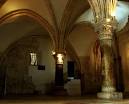
jerusalemshots.com
(Cenáculo) - Monte de Sión
478 × 387 - 117k - jpg |

veredgo.es
Monte Sión en Jerusalén.
932 × 620 - 64k - jpg |

christusrex.org
Vista del Monte Sión
384 × 342 - 41k - jpg |

israelviaje.com
del Monte Sión, rodeado de
640 × 265 - 125k - jpg |

guiasdeviajeonline.com
Monte Sion - Cenáculo
500 × 375 - 46k - jpg |
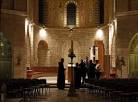
elmundo.es
Cenáculo del monte de Sión
657 × 486 - 49k - jpg |

christusrex.org
Monte Sión. Cenáculo y
5732 × 600 - 759k - jpg |

christusrex.org
Vista del Monte Sión
413 × 289 - 32k - jpg |

etheriaa.blogspot.com
Cenáculo. Monte Sión
1067 × 1600 - 246k - jpg |

christusrex.org
El Monte Sión (al centro de la
2868 × 600 - 273k - jpg |

es.wikipedia.org
Monte Sion. De Wikipedia
250 × 189 - 11k - jpg |

es.wikipedia.org
Vista del Monte
2263 × 1082 - 498k - jpg |

israelviaje.com
En la época de Jesus el
640 × 265 - 141k - jpg |

kadoshtours.blogspot.com
EL MONTE DE SION
200 × 134 - 9k - jpg |

losviajeros.com
era en monte de Sión,
640 × 407 - 37k - jpg |

viajestierrasanta2012....
Salida vía el Monte Scopus
1600 × 1147 - 334k - jpg |

blog.rtve.es
Puerta de Sión 5.- Monte Sión
550 × 405 - 58k |

pullmantur.es
Información sobre Monte Sión
608 × 240 - 51k - jpg |
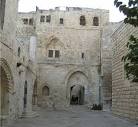
christusrex.org
La memoria de la Última Cena
653 × 600 - 71k - jpg |

es.catholic.net
El Cenáculo en el Monte Sión
150 × 150 - 7k - jpg |
|
|
|
|
|
MAPA DE LA VISITA

Pulsa aquí para acceder al mapa interactivo de nuestro recorrido por Jerusalén.
.
RECORRIDO
1.- Puerta de Jaffa
2.- Capilla de San Marcos
3.- Catedral de Santiago
4.- Puerta de Sión
5.- Monte Sión (Tumba del Rey David y Cenáculo)
6.- Valle de Josafat
7.- Puerta de los Escombros
8.- Calle Cardo
9.- Sinagoga Ramban
10.- Muro de las Lamentaciones
11.- Barrio de Mea Sharim
12.- Yad Vashem (museo del Holocausto)
13.- Iglesia del Santo Sepulcro (Monte Gólgota y Santo Sepulcro)
14.- Vía Dolorosa
15.- Puerta del León
16.- Monte de los Olivos
17.- Belén - Iglesia de la Natividad
|
|
|
|
|
MAPA DE LA VISITA

Pulsa aquí para acceder al mapa interactivo de nuestro recorrido por Jerusalén.
.
RECORRIDO
1.- Puerta de Jaffa
2.- Capilla de San Marcos
3.- Catedral de Santiago
4.- Puerta de Sión
5.- Monte Sión (Tumba del Rey David y Cenáculo)
6.- Valle de Josafat
7.- Puerta de los Escombros
8.- Calle Cardo
9.- Sinagoga Ramban
10.- Muro de las Lamentaciones
11.- Barrio de Mea Sharim
12.- Yad Vashem (museo del Holocausto)
13.- Iglesia del Santo Sepulcro (Monte Gólgota y Santo Sepulcro)
14.- Vía Dolorosa
15.- Puerta del León
16.- Monte de los Olivos
17.- Belén - Iglesia de la Natividad
|
|
|
|
|
 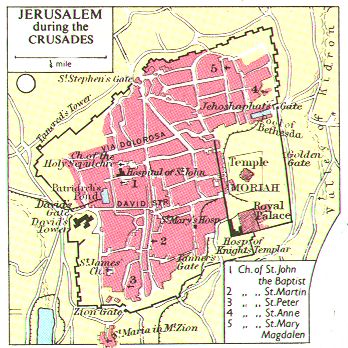
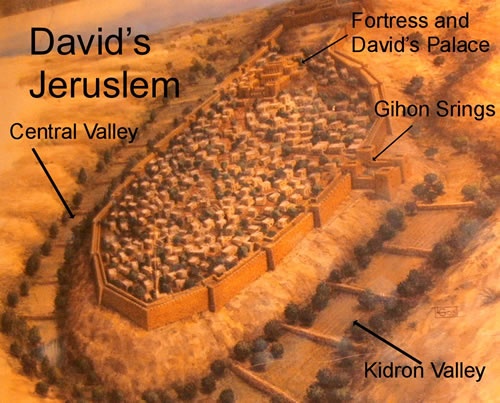
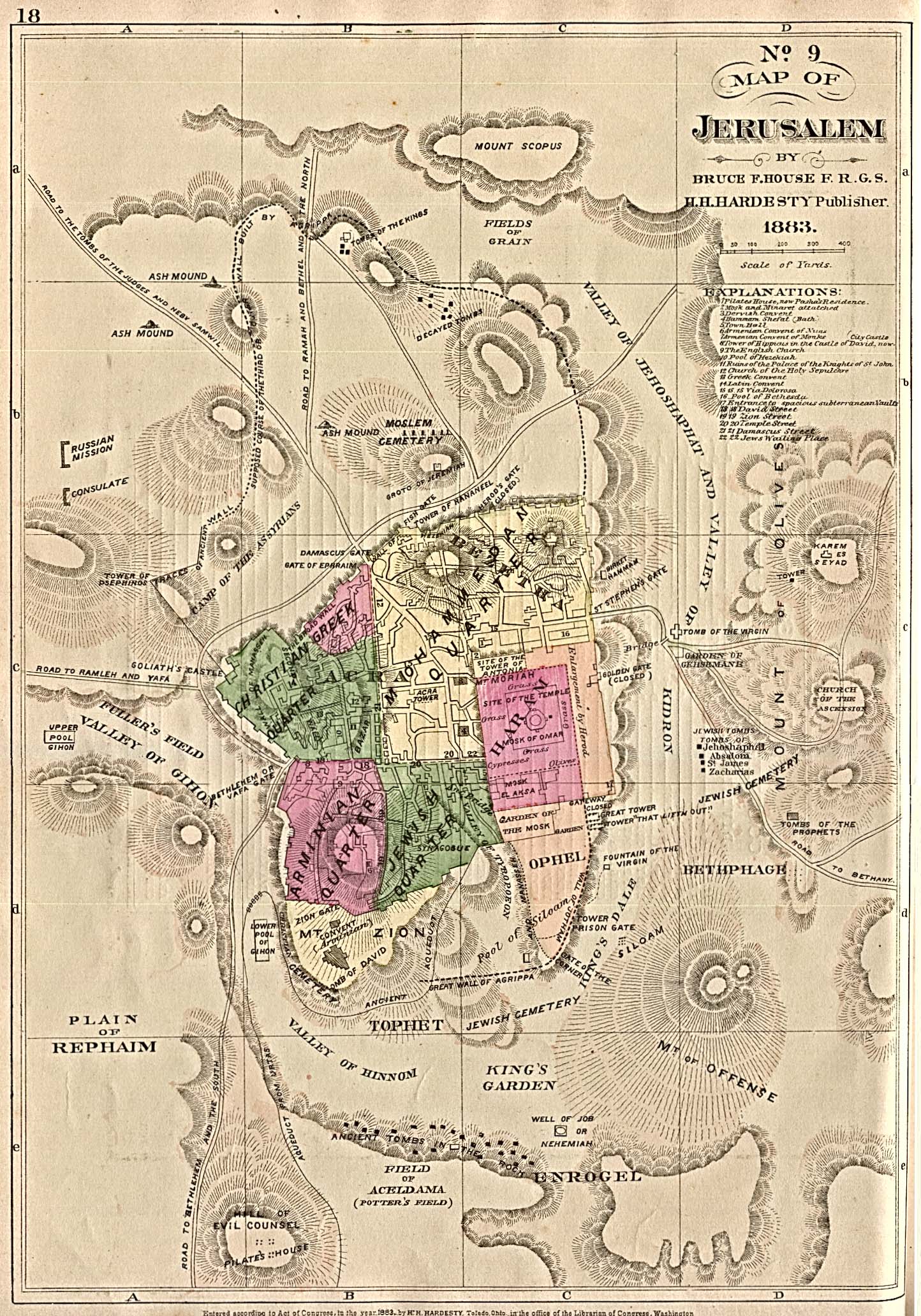
Dee Finney's blog
start date July 20, 2011
today's date December 24, 2013
page 615
TOPIC: THE HISTORY AND FUTURE OF JERUSALEM
THE BEGINNING OF THIS BLOG WAS GENERATED BY A PREVIEW OF A MOVIE COMING OUT PRODUCED BY PREACHER JOHN HAGEE ABOUT THE ARCHAEOLOGY OF JERUSALEM PROVING THE BIBLE CORRECTNESS OF THE PLACES AND PEOPLE INVOLVED IN ITS DEVELOPMENT.
THE FUTURE OF JERUSALEM HAS BEEN PROPHESIED MANY TIMES IN THE BIBLE AS WELL - INTO OUR OWN FUTURE TO BE CERTAIN.
JOHN'S HAGEE'S MOVIE IS COMING OUT ON DVD - TITLED 'THE CITY OF DAVID'. YOU CAN PURCHASE IT AT HIS WEBSITE:
-
- NOTES FROM HIS PROGRAM:
- JERUSALEM IS CNSIDERED THE NAVEL OF THE WORLD. IT COVERS AN AREA ONLY 1/2 MILE SQUARE. THE SITE OF JERUSALEM IS OF
GREAT RELIGIOUS IMPORTANCE - TO JEWS, MUSLIMS, AND CHRISTIANS.
- IT STILL HAS THE WESTERN WALL, THE DOME OF THE ROCK AT THE MOSQUE, AND THE CHURCH OF THE SEPLECHURE.
IT TRACES ALL THE BACK TO 4,000 BCE, AND IS ONE OF THE OLDEST CITIES IN THE WORLD.
DURING THAT TIME, ITS BEEN DESTROYED TWICE, BESEIGED 23 TIMES, ATTACKED 52 TIMES, AND CAPTURED AND RECAPTURED 44 TIMES.
WITIH LAYER UPON LAYER OF HIDDEN ARTIFACTS, IT IS AN ARCHOLOGIST'S DREAM AND A NIGHTMARE.
ONE CAN HARDLY MADE A STEP WITHOUT LIETERALLY AND FIGUARTIVELY STEPPING ON HOLY GROUND.
STARTING IN THE 19TH CENTURY, ARCHOLOGISTS BEGAN AT THE WESTERN WALL AND DISCOVERED ALL KINDS OF HISTORY ALL THE WAY TO EASTERN JERUSALEM.
IT PICKED UP AGAIN IN THE 1980'S. SINCE THEN SEVERAL NEW SITES HAVE BEEN OPENED TO VISITORS.
CITY OF DAVID:
KING DAVID WAS A MAJOR STATESMAN, ALSO A POET, AND A PROPHET. HE BROUGHT SCATTERED TRIBES TOGETHER AND PRODUCE A GOLDEN ERA OF ISRAEL.
HE BEGAN BY CONQUERING JERSALEM FROM THE JEBUSITES, BOUND TOGETHER THE NORTHERN AND SOUTHERN TRIBES, AND BROUGHT TOGETHER THIS NATION, AND JERUSALEM BECAME ITS CAPITAL CITY LIKE WASHINGTON D.C. IS IN THE UNITED STATES.
IT WAS ORIGINALLY CALLED DAVID'S CITY.
A CORNER OF DAVID'S HOUSE WITH TWO PILLARS STILL STANDS AT THE BOTTOM OF A HILL.
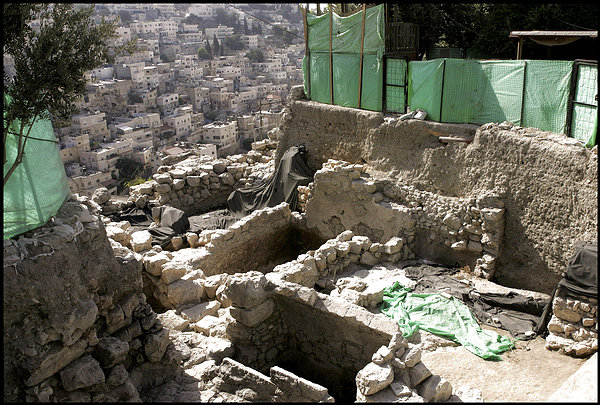 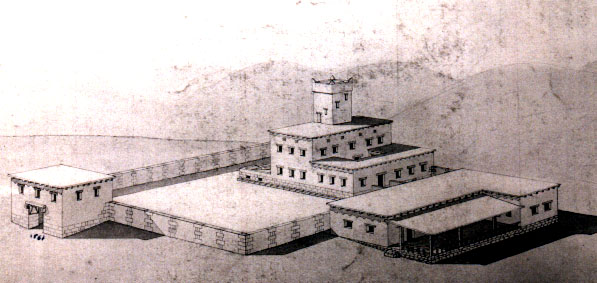
WE HAVE TO REMEMBER THAT OUR HOUSE WON'T LAST THAT LONG EITHER.
THE WELL THAT SUPPLIED THE WATER FOR DAVID'S HOUSE IS NOW THREE STORIES BENEATH ANOTHER HOUSE THAT WAS BUILT OVER IT.
- City of David is used to name the city after its conqueror (2 Samuel 5:7), though the term sometimes refers specifically to the original city David captured (2 Chronicles 32:5).
|
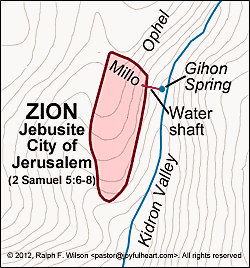
Map: Zion, Jebusite city of Jerusalem (2 Samuel 5:6-8). Larger map.
|
Jerusalem had its origins in the late fourth or early third millennium BC, with small settlements in the Chalcolithic and early Bronze I and II periods. By the early second millennium BC (Middle Bronze II), archaeologists have found evidence of a sizeable 12 acre walled town with a three foot thick wall with towers to protect the Gihon spring, as well as an underground water channel bringing water from the spring into the settlement at times when the city was under siege. The city also begins to show up in Egyptian texts as a small and minor part of Egyptian colonial rule, governed by a mayor rather than a king.
A "stepped stone structure" as part of the citadel apparently dates from the time of Jebusite rule in the late thirteenth to early twelfth centuries BC, at the end of the Late Bronze Age.
During the time of the Conquest under Joshua, Jerusalem had remained in Jebusite hands. Neither the tribe of Judah nor the tribe of Benjamin could dislodge them (Joshua 15:63; Judges 1:21), though at one point Judah had a successful raid against it (Judges 1:8). In David's time, the Jebusites and Israelites probably coexisted with some kind of state of truce between them, the Jebusites controlling the city and Judah controlling the land around the city.
We don't know much about the Jebusites, members of the Canaanite clan of Jebus. While they were considered Canaanites because they lived in Canaan (Genesis 10:16), they may have been a non-Semitic people related to the Hurrians or the Hittites. We may see a trace of this in Ezekiel's prophecy:
"Thus says the Lord God to Jerusalem: 'Your origin and your birth were in the land of the Canaanites; your father was an Amorite, and your mother a Hittite.'" (Ezekiel 16:3)
Because of the Jerusalem citadel's natural strength as a fortress, defended by walls as well as a steep slope on either side, the city felt impervious to attack. The narrator records that the Jebusites had taunted David's men:
"You will not get in here; even the blind and the lame can ward you off." (5:6b)
We might say something like, "Resisting you will be like child's play."
You can also read David's words to his men as a response to this taunt, as he laid out his strategy:
"Anyone who conquers the Jebusites will have to use the water shaft to reach those 'lame and blind' who are David's enemies." (5:8a)
Trying to piece together David's strategy is hindered because the nounṣinnôr, has been translated variously as "water shaft" (NIV, NRSV), "gutter" (KJV), and "grappling iron" (New English Bible).But I think that "water shaft" or "water supply" is probably correct, since the use of grappling hooks would mean scaling the impregnable fortress in full view of its defenders.
Ancient walled cities needed access to a water supply in order to survive in time of siege. Jerusalem relied on a single source, the Gihon spring, which was outside the Canaanite city walls, near the bottom of the Kidron Valley to the east of the city.
In 1998, excavations by Israeli archaeologists Ronny Reich and Eli Shukron demonstrated that the Gihon spring outside the city had been heavily fortified by the Canaanites with a massive tower (termed the "Spring Tower"). A complex system of underground passages, entered from within the city walls, took people to the edge of a pool fed by the spring, where they could draw water by letting down a bucket.
Of course, we don't know exactly how Joab and his men got into the city, but I expect that it reads like an episode from "Mission Impossible." Here's my attempt at a possible scenario, based on what we've learned from Reich's and Shukron's excavations:
Joab and his men somehow breach the massive Spring Tower and overcome its guards. They creep along a narrow water-filled channel (Channel II), then move up a narrow water-filled tunnel (Tunnel III) to get into the large underground water-storage pool. Here, they scale its walls to get to the cave-tunnel above, creep along a curved tunnel, its pitch blackness lit only by flickering lamps. Now they climb the tunnel's steep steps into a guard tower inside the city and overcome the guards. From there they creep out secretly, overcome more guards, and open the city gates so that David's troops can flood into the city and overwhelm it.
David laid out the strategy, and Joab volunteered for the assignment, with the promise that, if he succeeded, he would become David's commander (1 Chronicles 11:6).
Of course, we can only speculate on how the city fortress was entered. Perhaps they simply forced the city to surrender because they were able to cut off its water supply. But we know that David indeed captured it. Apparently, the existing Jebusite population was neither slaughtered nor displaced, for later David purchased a threshing floor from a Jebusite named Araunah (24:18-25), land that eventually became the site of Solomon's temple.
In addition to "Zion," its Canaanite name, Jerusalem is now called "The City of David," probably because David captured it with his own personal troops, rather than with an army gathered from levies on the various tribes. It becomes David's capital.
"David then took up residence in the fortress and called it the City of David. He built up the area around it, from the supporting terraces inward. And he became more and more powerful, because the LORD God Almighty was with him." (5:9-10)
The narrator explains that David "built up the area around it, from the supporting terraces inward." The word translated "supporting terraces" (NIV) or "the Millo" (NRSV, KJV, from Hebrew millōʾ), apparently means "what is full" or "what fills the gap," or both. British archaeologist Kathleen Kenyon contends that this complex of terracing on the eastern slope of Ophel is a Jebusite structure built to support houses on the incline of the hill, retaining walls with leveled filling. David, Solomon, and later kings repair and extend these terraces.
David's palace is built by Hiram, king of Tyre, who sends timber from the cedars of Lebanon, as well as skilled carpenters and stonemasons. This aid no doubt represents a treaty that David has made with the descendants of the Phoenicians, Israel's neighbors to the northwest along the coast.
The children born to David in Jerusalem are mentioned here also.
ON THE SIDE OF THE HILL ACROSS FROM DAVID'S HOUSE ARE STILL GRAVES FROM TEH ERA OF KING DAVID.
A LITTLE FURTHER OVER IS THE ORIGINAL WALL OF ANCIENT JERUSALEM. ON THE SLOPE NEXT TO IT IS WHERE ABRAHAM B BROUGHT IS SON ISAAC TO BE SACRIFICED TO THE LORD ON MOUNT MORIAH.
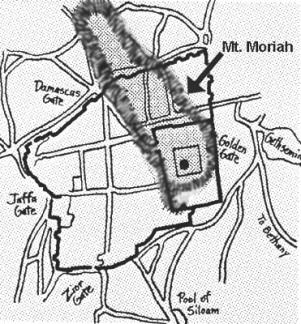
THE ORIGINAL ROAD THROUGH JERSALEM IS BURIED BENEATH THE CURRENT ROAD.
http://www.greatdreams.com/blog-2013-3/dee-blog615.html |
|
|
|
|
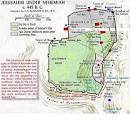
heavenawaits.wordpress...
Lions' Gate (Hebrew: שער
700 × 701 - 121k - jpg |
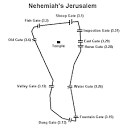
jesusplusnothing.com
So for each gate we will
479 × 487 - 5k - gif |

israel-a-history-of.com
Ancient Jerusalem of the Tribe
344 × 525 - 70k - jpg |

en.wikipedia.org
Location in Old Jerusalem
923 × 977 - 392k - png |
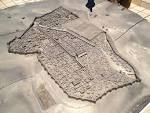
emp.byui.edu
For example, "Benjamin," is
1024 × 768 - 479k - jpg |
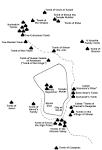
generationword.com
Valley - Jerusalem 101
900 × 1320 - 107k - jpg |

greatdreams.com
ancient jerusalem map
500 × 451 - 132k - jpg |
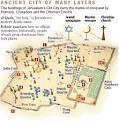
templemount.org
Turkish Sultan Suleiman the
363 × 372 - 118k - gif |
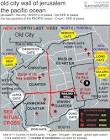
gabitogrupos.com
EN REALIDAD TAMBIEN EN LA
566 × 720 - 182k - gif |
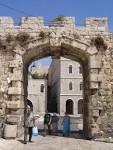
en.wikipedia.org
New Gate
2304 × 3072 - 1392k - jpg |

templemount.org
The gate that bears his name
397 × 595 - 44k - jpg |

shechem.org
The Gates of Jerusalem.
325 × 290 - 32k - jpg |

israel-a-history-of.com
Ancient Jerusalem Map
450 × 286 - 27k - jpg |

en.wikipedia.org
called the Benjamin Gate.
200 × 284 - 17k - jpg |

biblesearchers.com
The Eastern Gate to the city
300 × 523 - 48k - jpg |

jewishencyclopedia.com
—Ancient: Cross-Sectional View of Jerusalem (West to East) as Seen from the
822 × 252 - 49k - jpg |
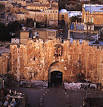
keyway.ca
The Lion Gate at Jerusalem
213 × 222 - 16k - jpg |
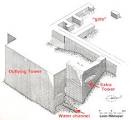
ritmeyer.com
The Water Gate of Jerusalem
500 × 461 - 130k - jpg |
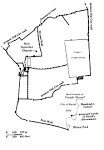
becomingone.org
Jerusalem [click to enlarge]
800 × 1157 - 23k - gif |

dabar.org
Plan of Jerusalem
640 × 565 - 136k - gif |
|
|
|
|
|
Lions' Gate
From Wikipedia, the free encyclopedia

Detail of Lions' Gate carvings, actually of leopards[1]
The Lions' Gate (Hebrew: שער האריות Sha'ar Ha'Arayot, Arabic: باب الأسباط, also St. Stephen's Gate or Sheep Gate) is located in the Old City Walls of Jerusalem and is one of seven open Gates in Jerusalem's Old City Walls.
Located in the east wall, the entrance marks the beginning of the traditional Christian observance of the last walk of Jesus from prison to crucifixion, the Via Dolorosa. Near the gate’s crest are four figures of leopards, often mistaken for lions, two on the left and two on the right. They were placed there by Sultan Suleiman the Magnificent to celebrate the Ottoman defeat of the Mamluks in 1517. Legend has it that Suleiman's predecessor Selim I dreamed of lions that were going to eat him because of his plans to level the city. He was spared only after promising to protect the city by building a wall around it. This led to the lion becoming the heraldic symbol of Jerusalem.[2] However, Jerusalem already had been, from Biblical times, the capital of the Kingdom of Judah, whose emblem was a lion (Genesis 49:9).[3]
In another version,[citation needed] Suleiman taxed Jerusalem's residents with heavy taxes which they could not afford to pay. That night Suleiman had a dream of two lions coming to devour him. When he woke up, he asked his dream solvers what his dream meant. A wise respected man came forward and asked Suleiman what was on his mind before drifting to sleep. Suleiman responded that he was thinking about how to punish all the men who didn't pay his taxes. The wise man responded that since Suleiman thought badly about the holy city, God was angry. To atone, Suleiman built the Lions' Gate to protect Jerusalem from invaders.
Israeli paratroops from the 55th Paratroop Brigade came through this gate during the Six-Day War of 1967 and unfurled the Israeli flag above the Temple Mount.
The Lions' Gate is not to be confused with the Zion Gate in the Old City Wall, located in the south, leading to the Jewish and Armenian Quarters.
The magnificent walls of Jerusalem's Old City were built by the Ottoman Empire under the direct supervision of Sultan Suleiman in 1542. The walls stretch for approximately 4.5 kilometers (2.8 mi) and rise to a height of 5–15 meters (16–49 ft), with a thickness of 3 meters (9.8 feet).[4] All together, the Old City walls contain 43 surveillance towers and 11 gates, seven of which are presently open.
References[edit]
- ^ Jerusalem municipality website
- ^ Jerome Murphy-O'Connor, The Holy Land: an Oxford archaeological guide from earliest times to 1700, 2008, p. 21, ISBN 978-0-19-923666-4
- ^ [1]
- ^ The Jerusalem Post Millennium Special
External links[edit]
|
|
|
|
|
|
en.wikipedia.org/wiki/Lions'_Gate
For other meanings, see Lions' Gate (disambiguation). ... Lions' Gate is located in
Jerusalem ... This led to the lion becoming the heraldic symbol of Jerusalem.
allaboutjerusalem.com/article/lions-gate-jerusalems-old-city-walls
The gate gets its name from the pairs of stone “lions” seen on either side of the
gate's façade.
|
|
|
|
www.youtube.com/watch?v=jqGdz3UyL7k27 Sep. 2012 - 1 min. - Subido por JerusalemExperience - Video Tours in Jerusalem
http://jerusalemexperience.com/location/jerusalem-gates/ The Lions' Gate is one of the ... |
www.soulsofdistortion.nl/great%20celestial%20conjunction%20crosses2.html
In ancient Babylon the Akkadian god Shamash (Sumerian Sun god Utu) was ... At
a right angle to the walls of the gate we find a wall adorned with lions! ..... Notice
that the azimuth of the winter solstice sunrise at Dendera is 116 º 30'. ...... Ark of
the Covenant that they retrieved from Solomon's temple in Jerusalem to Chartres
...
www.greatdreams.com/sun_database.htm
Knowledge is given of I, to Gate of Sun - known to earth. .... THE NEW
JERUSALEM ACCORDING TO REVELATIONS .... the azimuth of the Sun goes
from south declination to north declination ... an "Age of .... www.greatdreams.
com/lion.htm - ...
www.gabitogrupos.com/...LAS_FALSAS.../template.php?nm...
16 Ene 2012 ... Venus Conjunct Sun & Mercury Conjunct Venus & Mercury ... the four angels Ox
Lion Eagle and Man .... 10:22 Celebrábase en Jerusalén la fiesta de la
dedicación. ...... At summer solstice the Sun at Stonehenge rises at 50º azimuth in
... reasonable to suspect that the gate or portal mentioned in the Book of ...
www.gabitogrupos.com/...LAS_FALSAS.../template.php?nm...
23 Oct 2011 ... He presents here a resume and the results of his chief book, Sun, Moon &
Stonehenge. ... that the axis of Stonehenge aligns approximately to the
midsummer rising sun azimuth. ...... First of all, let's address the FACT that
Jerusalem was first called Salem. ...... lionsgate in Simple Gematria Equals: 102, (
, l ...
|
|
|
|
|
|
| lionsgate in Simple Gematria Equals: 102 |
( |
l
12 |
i
9 |
o
15 |
n
14 |
s
19 |
g
7 |
a
1 |
t
20 |
e
5 |
) |
| lions in Simple Gematria Equals: 69 |
( |
l
12 |
i
9 |
o
15 |
n
14 |
s
19 |
) |
| gate in Simple Gematria Equals: 33 |
( |
g
7 |
a
1 |
t
20 |
e
5 |
) |

EL SOL, SI USTED MIRA HACIA EL NORTE Y EN EL CONTEXTO A QUE EL MISMO SALE POR EL ESTE Y SE PONE EN EL OESTE, SE MUEVE EN SENTIDO HORARIO, osea el mismo numero 6 y LA LUNA, en su movimiento de 29.53059 dias SALE EN EL OESTE Y SE PONE EN EL OESTE, osea que se mueve en sentido antihorario. SOL-O-MON / DOS LUMBRERAS / CUARTO DIA DE LA CREACION / MIERCOLES / MERCURIO / GOD /DOG / CONVERSION DEL MERCURIO EN ORO / ALQUIMIA /SANTO GRIAL. EL FLUJO MAGNETICO DE UNA BOBINA simula incluso al flujo del agua de un rio que simboliza al FLUJO DEL AGUA VIVA, simbolo del ESPIRITU SANTO/PENTECOSTES/SHAVUOT. El mismo flujo simboliza a la UNION ENTRE EL HOMBRE Y LA MUJER, ya que observamos se dan los dos tipos de flujos ya sean en sentido horario o antihorario.
En Hechos 12:12 (1+2,1+2:3,3 o 33) es PEDRO el que aparece con Maria la madre de Juan Marcos.
Hechos 12:12: Y habiendo considerado esto, llegó a casa de María la madre de Juan, el que tenía por sobrenombre MARCOS, donde muchos estaban reunidos orando.
La mujer le dijo: Señor, no tienes con qué sacarla, y el pozo es hondo. ¿De dónde, pues, tienes el AGUA VIVA?
4. Juan 7:38: El que cree en mí, como dice la Escritura, de su interior correrán ríos de AGUA VIVA
EL AGUA VIVA, ES UNA REFERENCIA ESPIRITUAL AL FLUJO DEL ESPIRITU SANTO. OBSERVEN QUE EL CANGREJO TIENE FORMA DE FLUJO, ADONDE OBSERVAMOS QUE EN LA PARTE SUPERIOR TIENE UN SENTIDO Y EN LA PARTE INFERIOR TIENE OTRO. SABEMOS QUE UN RIO DE AGUA VIVA TIENE AMBOS FLUJOS. ES POR ESO QUE NUESTRO SEÑOR JESUCRISTO HIZO REFERENCIA AL AGUA VIVA A LA SAMARITANA. EL MENSAJE DE NUESTRO SEÑOR ESOTERICO DE NUESTRO SEÑOR ES OBVIO. YO TAMBIEN TENGO UNA ESPOSA Y ESO EXPLICA DEL PORQUE LA INTERRELACION DEL ESPIRITU SANTO CON EL AGUA VIVA. SABEMOS QUE LAS PRESAS O DIQUES SON GENERADORES DE ELECTRICIDAD.
En los rios, al igual que en los campos magneticos tambien tenemos el flujo horario que simboliza al hombre y el flujo antihorario que simboliza la mujer.
Juan 20
1. El primer día de la semana, María Magdalena fue de mañana, siendo aún oscuro, al sepulcro; y vio quitada la piedra del sepulcro. (AUN NO HABIA SALIDO EL SOL)
2. Entonces corrió, y fue a Simón Pedro y al otro discípulo, aquel al que amaba Jesús, y les dijo: Se han llevado del sepulcro al Señor, y no sabemos dónde le han puesto. (El discipulo amado es JUAN MARCOS, el hijo de Nuestro Señor y Nuestra Señora madre)
3. Y salieron Pedro y el otro discípulo, y fueron al sepulcro.
4. Corrían los dos juntos; pero el otro discípulo corrió más aprisa que Pedro, y llegó primero al sepulcro.
5. Y bajándose a mirar, vio los lienzos puestos allí, pero no entró.
6. Luego llegó Simón Pedro tras él, y entró en el sepulcro, y vio los lienzos puestos allí,
7. y el sudario, que había estado sobre la cabeza de Jesús, no puesto con los lienzos, sino enrollado en un lugar aparte.
8. Entonces entró también el otro discípulo, que había venido primero al sepulcro; y vio, y creyó.
9. Porque aún no habían entendido la Escritura, que era necesario que él resucitase de los muertos.
10. Y volvieron los discípulos a los suyos.
11. Pero María estaba fuera llorando junto al sepulcro; y mientras lloraba, se inclinó para mirar dentro del sepulcro;
12. y vio a dos ángeles con vestiduras blancas, que estaban sentados el uno a la cabecera, y el otro a los pies, donde el cuerpo de Jesús había sido puesto.
13. Y le dijeron: Mujer, ¿por qué lloras? Les dijo: Porque se han llevado a mi Señor, y no sé dónde le han puesto.
14. Cuando había dicho esto, se volvió, y vio a Jesús que estaba allí; mas no sabía que era Jesús.
15. Jesús le dijo: Mujer, ¿por qué lloras? ¿A quién buscas? Ella, pensando que era el hortelano, le dijo: Señor, si tú lo has llevado, dime dónde lo has puesto, y yo lo llevaré.
16. Jesús le dijo: ¡María! Volviéndose ella, le dijo: ¡Raboni! (que quiere decir, Maestro).
17. Jesús le dijo: No me toques, porque aún no he subido a mi Padre; mas ve a mis hermanos, y diles: Subo a mi Padre y a vuestro Padre, a mi Dios y a vuestro Dios.
18. Fue entonces María Magdalena para dar a los discípulos las nuevas de que había visto al Señor, y que él le había dicho estas cosas. (Observen que MARIA MAGDALENA CONCLUYE LA REDENCION DE NUESTRO SEÑOR. MARIA MAGDALENA TAMBIEN ES COREDENTORA)
19. Cuando llegó la noche de aquel mismo día, el primero de la semana, estando las puertas cerradas en el lugar donde los discípulos estaban reunidos por miedo de los judíos, vino Jesús, y puesto en medio, les dijo: Paz a vosotros. (Para JUAN o el escritor del CUARTO EVANGELIO CRISTO JESUS RESUCITO EN PENTECOSTES. INCREIBLEMENTE LA FIESTA DE ISTAR ERA EN EL VERANO. OSEA QUE MARIA LA MAGDALENA ES LA NUEVA ISTAR/ISHTAR. Noten la interrelacion con las "PUERTA CERRADAS" es una obvia referencia a la PUERTA DE ISTAR. EL MENSAJE ESTA CLARO. ¿PORQUE CRISTO SE LE APARECIO A MARIA LA MAGDALENA EN PENTECOSTES O SINO PORQUE AQUI JUAN HACE REFERENCIA A PENTECOSTES?)
20. Y cuando les hubo dicho esto, les mostró las manos y el costado. Y los discípulos se regocijaron viendo al Señor.
21. Entonces Jesús les dijo otra vez: Paz a vosotros. Como me envió el Padre, así también yo os envío.
22. Y habiendo dicho esto, sopló, y les dijo: Recibid el Espíritu Santo. (Aqui se confirma que la referencia es a PENTECOSTES. Esto es una referencia a CANCER/AGUA VIVA/SOL Y LUNA/SOL-O-MON / MERCURIO / MIERCOLES /CUARTO DIA DE LA CREACION /ALQUIMIA / GRIAL. EL 5 justamente tiene referencia a la CUADRATURA DEL CIRCULO. EL CUADRADO EN SU PARTE SUPERIOR Y EL CIRCULO EN LA INFERIOR. Aunque CRISTO NO HAYA RESUCITADO EN PENTECOSTES, pero esta claro que LA INTERRELACION ESTA.)
23. A quienes remitiereis los pecados, les son remitidos; y a quienes se los retuviereis, les son retenidos.
MATEO 24
26. Así que, si os dijeren: Mirad, está en el desierto, no salgáis; o mirad, está en los aposentos, no lo creáis.
27. Porque como el relámpago que sale del oriente y se muestra hasta el occidente, así será también la venida del Hijo del Hombre.
28. Porque dondequiera que estuviere el cuerpo muerto, allí se juntarán las águilas.
29. E inmediatamente después de la tribulación de aquellos días, el sol se oscurecerá, y la luna no dará su resplandor, y las estrellas caerán del cielo, y las potencias de los cielos serán conmovidas. (Una referencia al CUARTO DIA DE LA CREACION en que fueron creadas las dos lumbreras y las estrellas. Nosotros sabemos que en la semana actual el MIERCOLES/MERCURIO es el cuarto dia. UNA REFERENCIA A LA ALQUIMIA, OSEA EL GRIAL)
30. Entonces aparecerá la señal del Hijo del Hombre en el cielo; y entonces lamentarán todas las tribus de la tierra, y verán al Hijo del Hombre viniendo sobre las nubes del cielo, con poder y gran gloria.
31. Y enviará sus ángeles con gran voz de trompeta, y juntarán a sus escogidos, de los cuatro vientos, desde un extremo del cielo hasta el otro.
32. De la higuera aprended la parábola: Cuando ya su rama está tierna, y brotan las hojas, sabéis que el verano está cerca. (El verano es PENTECOSTES)
33. Así también vosotros, cuando veáis todas estas cosas, conoced que está cerca, a las
puertas. (Observen la referencia a las PUERTAS. YHWH MANEJA TODO. ESTA TODO CODIFICADO PARA MALDICION DE LOS EGOLATRAS.)
STAR GATE
Juan 4
1. Cuando, pues, el Señor entendió que los fariseos habían oído decir: Jesús hace y bautiza más discípulos que Juan
2. (aunque Jesús no bautizaba, sino sus discípulos),
3. salió de Judea, y se fue otra vez a Galilea.
4. Y le era necesario pasar por Samaria.
5. Vino, pues, a una ciudad de Samaria llamada Sicar, junto a la heredad que Jacob dio a su hijo José. (JOSE, EL HIJO DEL SOL/JACOB Y LA LUNA/RAQUEL, SEGUN EL SUEÑO DE JOSE DE GENESIS 37, JOSE ES LA ESTRELLA. AQUI HAY UNA REFERENCIA A LA FIESTA DE ISHTAR/SHAVUOT/STAR/ESTRELLA. SOL-O-MON, SOL Y LUNA, CUARTO DIA DE LA CREACION, MIERCOLES, MERCURIO, ALQUIMIA, ETC,ETC)
6. Y estaba allí el pozo de Jacob. Entonces Jesús, cansado del camino, se sentó así junto al pozo. Era como la hora sexta.
7. Vino una mujer de Samaria a sacar agua; y Jesús le dijo: Dame de beber.
8. Pues sus discípulos habían ido a la ciudad a comprar de comer.
9. La mujer samaritana le dijo: ¿Cómo tú, siendo judío, me pides a mí de beber, que soy mujer samaritana? Porque judíos y samaritanos no se tratan entre sí. (JESUS ERA JUDIO PARA BRONCA DE LOS NAZIS)
10. Respondió Jesús y le dijo: Si conocieras el don de Dios, y quién es el que te dice: Dame de beber; tú le pedirías, y él te daría agua viva. (CRISTO JESUS COMPARA AL ESPIRITU SANTO CON EL AGUA VIVA O AGUA EN MOVIMIENTO, OSEA UN RIO)
11. La mujer le dijo: Señor, no tienes con qué sacarla, y el pozo es hondo. ¿De dónde, pues, tienes el agua viva?
12. ¿Acaso eres tú mayor que nuestro padre Jacob, que nos dio este pozo, del cual bebieron él, sus hijos y sus ganados?
13. Respondió Jesús y le dijo:Cualquiera que bebiere de esta agua, volverá a tener sed;
14. mas el que bebiere del agua que yo le daré, no tendrá sed jamás; sino que el agua que yo le daré será en él una fuente de agua que salte para vida eterna.
15. La mujer le dijo: Señor, dame esa agua, para que no tenga yo sed, ni venga aquí a sacarla.
16. Jesús le dijo: Ve, llama a tu marido, y ven acá.
17. Respondió la mujer y dijo: No tengo marido. Jesús le dijo: Bien has dicho: No tengo marido;
18. porque cinco maridos has tenido, y el que ahora tienes no es tu marido; esto has dicho con verdad.
19. Le dijo la mujer: Señor, me parece que tú eres profeta.
20. Nuestros padres adoraron en este monte, y vosotros decís que en Jerusalén es el lugar donde se debe adorar.
21. Jesús le dijo: Mujer, créeme, que la hora viene cuando ni en este monte ni en Jerusalén adoraréis al Padre. (CRISTO JESUS, COMO BUEN JUDIO, ERA UNITARIO, NO TRINITARIO)
22. Vosotros adoráis lo que no sabéis; nosotros adoramos lo que sabemos; porque la salvación viene de los judíos.
23. Mas la hora viene, y ahora es, cuando los verdaderos adoradores adorarán al Padre en espíritu y en verdad; porque también el Padre tales adoradores busca que le adoren.
24. Dios es Espíritu; y los que le adoran, en espíritu y en verdad es necesario que adoren.
25. Le dijo la mujer: Sé que ha de venir el Mesías, llamado el Cristo; cuando él venga nos declarará todas las cosas.
26. Jesús le dijo: Yo soy, el que habla contigo.
27. En esto vinieron sus discípulos, y se maravillaron de que hablaba con una mujer; sin embargo, ninguno dijo: ¿Qué preguntas? o, ¿Qué hablas con ella?
28. Entonces la mujer dejó su cántaro, y fue a la ciudad, y dijo a los hombres:
29. Venid, ved a un hombre que me ha dicho todo cuanto he hecho. ¿No será éste el Cristo?
30. Entonces salieron de la ciudad, y vinieron a él.
31. Entre tanto, los discípulos le rogaban, diciendo: Rabí, come.
32. El les dijo: Yo tengo una comida que comer, que vosotros no sabéis.
33. Entonces los discípulos decían unos a otros: ¿Le habrá traído alguien de comer?
34. Jesús les dijo: Mi comida es que haga la voluntad del que me envió, y que acabe su obra.
35. ¿No decís vosotros: Aún faltan cuatro meses para que llegue la siega? He aquí os digo: Alzad vuestros ojos y mirad los campos, porque ya están blancos para la siega. (Aqui se confirma que el VERDADERO SHAVUOT/PENTECOSTES es en el quinto mes hebreo 29 de thamus/primero de Av EN LUNA LLENA EN SOLSTICIO)
 |
| Río Magdalena a la altura de Mompox, Bolívar |
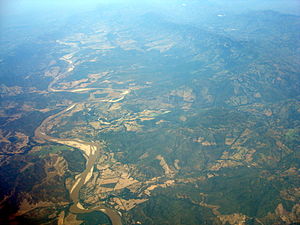 |
| El Magdalena a su paso entre Cundinamarca y Tolima. |
MARCA/MARCOS
|
|
|
 Primer
Primer
 Anterior
2 a 16 de 196
Siguiente
Anterior
2 a 16 de 196
Siguiente Último
Último
|


The blade and chalice guarding o'er her gates.
Adorned in masters' loving art, she lies.
She rests at last beneath the starry skys.